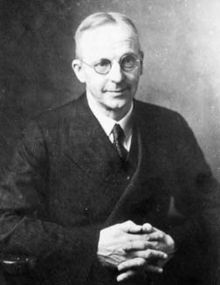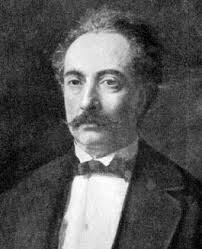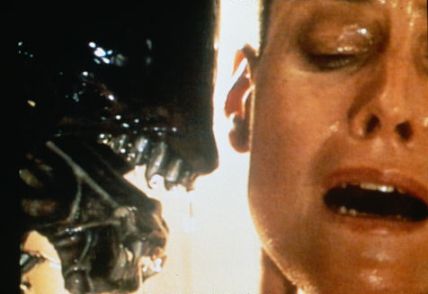 E.T. Whittaker – Mathematical Physicist (1873 – 1956)
E.T. Whittaker – Mathematical Physicist (1873 – 1956)
“What these gentlemen call vacuum isn’t really
nothing but something which is not matter”
(Caroline Ansbach, letter to Leibniz)
Here is a minor fiction, which speaks to mathematical fashion. Once upon a time, in a far away galaxy, there were twin planets, carrying the twins Primo and Ultimo. On giving them some mathematical tools their differences in character become readily apparent.
Primo asserts:
“Oh, what nice tools! I will make the same as you only better!”
Ultimo counters:
“Oh, what nice tools! I will make something different and hope you like it!”
One wonders how deeply people think on their own sayings. Is there any time at all to think in the face of such enormous growth in the scientific literature and bibliographic material?
Do we read others just to differ or only to better?
The exponential growth of bibliography from the 19th century onward should make any sane civilization worry about how to handle the complexity of such a task.
In understanding some of the consequences of this, we consider the cognitive dissonance caused by any the concept of “a vacuum” and that of “nothingness”.
Most people find it difficult to conceive of anything with an existence of any kind between material objects without this “additional” existence being able to exert some kind of resistance or “friction” for that matter.
The famous Michelson-Morley experiment probed exactly that. Was there an Aether existing between substances that supported electromagnetic vibrations of a something?
Let’s look at this from a modern viewpoint. Consider space walks. Such an experience would appear to be one of the utmost freedom, without anything in the vacuum of space impeding us. But think again! How naive that would sound to any person trained in the fundamentals of General Relativity?
In fact, there is nothing really free at all in a situation of “Free Fall”!
I have never heard of any phrase with such an inherently self-contradictory attitude than the expression “Free Fall” as normally used in GR! Surely, no other state of motion is less “free” than the one constrained to move along a precisely tuned Geodesic!
The affront to our freedom lies in the Platonic domain, that line of thought of Einstein himself on the nature of Space-Time. What restricts the motion out there amidst all the nothingness of the world? It is the successor… to “Newtonian potentials”, GR being the
greatest “potential” theory ever made – matter tells space how to curve, space tells matter how to move. The two are co-dependent.
And what exactly is a potential? Is it a bird?, Is it a plane? Is it a tangible thing? Well, it seems that somehow, that it is and it is not. Let us call this intangible existence a state of “something” at the moment.
[Ed. Within the context of electromagnetism and source theory we can see the role of the Green’s function in helping eliminate “the source” in favor of “the potential”. Matter and field are two sides of one indivisible phenomenon.]
One might imagine cartoons appearing on a TV screen and ask if there is any kind of “resistance” to their own motion from the screen itself? What does the image move through if not nothing? Of course, it is a phase relationship of one pixel to its neighbor. Something can move while being itself nothing.
Scientific perspectives can be fluid, as illustrated by a quote in the recent book Contact Geometry and Topology. The first chapter contains the remark (p. 2):
“Since electrodynamics is just a part of mechanics, the discovery made in 2009 can be attributed only to systematic eradication of historical facts from scientific textbooks and monographs.”
I remembered then, in my own college days, never having being informed by anyone on the existence of curl eigenfields nor of the important work by Eugenio Beltrami, mentioned in my previous post. It was as if an invisible hand had erased any memory of it!
It is the Parable of Primo and Ultimo in the context of scientific fashion. When once something is done we make it better or different to the point of forgetting. For institutions that are being paid for teaching you this resembles the art of misdirection used by trickster magicians and card game bluffers.
Your attention is moved to where the educator wanted.
Using this trick, anything or anyone that does not conform to our present axiomatic framework will be cast as marginal and boring. It lies in the realm of specialized techniques, that will only be taught in the extreme situation that we may need to make use of such former wisdom for a demarcated purpose.
This thought causes me to go back a hundred years and check in on the problem of vacuum vs nothingness. The question concerns evidence for “Super-potentials” and Theories of the Aether, due to English Prof. Edmund T. Whittaker. The description of his contribution may be found here.
Whittaker had a certain animosity towards Einstein’s theory of Special Relativity. This was, in part, because Whittaker had invented himself a simple theory in one of his most influential papers in 1904 only that it was superseded by Einstein’s work in 1905 to end up on the shelves.
[Ed. Whittaker appeared to view history through the lens of the Aether and thus took a different perspective. Of course, Einstein was the guy who banished the Aether so perhaps this explains some of the animosity.]
My purpose is to trace the reconciliation of relativistic theories with the previous analysis by Whittaker. It involves recalling his work on the super-potential theory.
The relevant papers are:
1) On the partial differential equations of mathematical physics which develops a general solution of Laplace’s equation through a novel decomposition of the field into two pieces;
2) On an expression of the electromagnetic field due to electrons by means of two scalar potential functions which expresses the electron field in terms of derivatives of two auxiliary scalar potentials
These early works anticipate somewhat the Transactional Interpretation of Quantum Electrodynamics due to John G. Cramer, which itself evolved from the Wheeler and Feynman Source-Absorber theory of photon exchange.
[Ed. Whittaker may perhaps be understood, even if you disagree with his viewpoint, as following a path different from the now conventional Green’s function approach to solving for the field given its sources.]
The Whittaker separation of the electron field into two non-symmetric parts are referred to here as Super-potentials. Their value lies in the fact that both the fields and the first level potentials for such fields can be constructed from an originating potential without any recourse to vector fields. In a different view, these might represent the actual, independent degrees of freedom of the fields, akin to a “basis” or an irreducible representation but not in the ordinary sense of a linear algebra including of course the necessary gauge degrees of freedoms.
Interestingly enough, the first Whittaker scalar, if parametrized in spherical coordinates, shows an interesting periodic structure while the second is akin to a “phase” angle. In the 1930s, H.S. Ruse discovered that the Whittaker scalars represent the Principal Null Directions of the Hertzian tensor in the fully covariant relativistic expression of Maxwell equations due to Heinrich Hertz. This result followed his earlier anticipation of a connection between super-potentials and relativity.
Surprisingly enough, Ruse managed to find a direct association of this basis with the Dirac equation. In fact, the Dirac theory seems possible without explicit use of spinors due to an equivalent form offered by the Whittaker scalars! Little attention seems to have been paid to these facts by the rest of the physics community.
Some fifty years later the connection between Hertzian, Whittaker and relativistic theories was revived by Japanese researcher Prof. Hideki Kawaguchi Prof. Hideki Kawaguchi. Kawaguchi published a series of articles from 1988 to 1995, working from the Hertzian formulation to the standard Lienard-Wiechert potentials, with a connection to the spinorial version of Dirac wave-functions.
Coming back to our previous “vacuum vs nothingness” question, Kawaguchi illustrates the connections on five levels. At the lowest fifth level, where the super-potentials lie, the complexity of radiation reaction shows up in the relations among these potentials in analogy to the Lorentz Force in a more conventional treatment.
The theme of “advanced” waves and signals from the future resurfaces here, underscoring the complexity of any discussion of causality in the electron system. Such considerations, working from advanced waves, led John Cramer to speculate on Retrocausality and a possible series of experiments to look for such effects.
[Ed. The key issue, much like tests of the Bell inequality, is whether any information can be transmitted in such a scheme of advanced and retarded waves. Considerations of relativity would suggest not, much like the lack of any super-luminal signalling potential in the EPR experiments to test Bell and Leggett inequalities.]
This exploration of super-potentials calls attention to an old allegory of Plato. In his defense of “Ideas” as superior to “Things” (the Cartesian “Res Extensa”) Plato considers a grand piece of marble. Before the sculptor starts work, one may conceive of all possible statues being contained in that initial marble. Thus the monolithic marble represents a universe of potentialities from which our consciousness gradually shapes at least one.
This “shaping” procedure in natural law seems to incorporate a kind of “Occam’s Razor” – a principle of economy in the logical structure of theories. Perhaps this has something to do with the super-potential idea as being a level down in the hierarchy, which leads to those layers above.
In contrast, strings, branes, and other popular speculations upon a deeper level, seem to be less constrained and may therefore seem less in tune with Occam’s Razor. According to the ancient meaning of the Greek word “Cosmos” which originates in the verb “Cosme’o” (to decorate) the true meaning of the Cosmos must be “The Jewel”!

 E.T. Whittaker – Mathematical Physicist (1873 – 1956)
E.T. Whittaker – Mathematical Physicist (1873 – 1956)

